Learn how fire sprinklers work—and why they work so reliably
Forget everything you’ve seen in the movies. Fire sprinklers are not activated by smoke, nor do they all go off at once during a fire and soak everything in a building (unless, of course, you purposely install a deluge sprinkler system). Fire sprinklers are activated by heat, one sprinkler at a time—and in 85 percent of fires, only one sprinkler head is needed to control the blaze. So, exactly what causes a fire sprinkler to activate?
In this blog, we explain what trips a fire sprinkler, so property owners can rest assured that they are protected from fire and unnecessary water damage. We also examine how we measure the heat sensitivity of a sprinkler head and how a sprinkler’s heat-sensitive parts work together to sense danger and send flame-retarding water flowing onto a fire.
Looking to purchase fire sprinkler heads for your system? View our in-stock selection of commercial pendent, upright, sidewall, and concealed fire sprinklers, or our selection of residential fire sprinklers.
Water, water everywhere: why water still wages the best defense against fire
Fires rank as a leading cause of preventable accidental deaths in the U.S. And many times, automatic fire sprinklers are all that stand between a building and its occupants and an out-of-control fire. The invention of automatic sprinklers revolutionized fire safety with the ability to spontaneously extinguish fires where they start—and to prevent them from spreading or re-igniting. When installed properly, the National Fire Protection Association (NFPA) reports that fire sprinklers control or extinguish the fire that activates them a whopping 96 percent of the time.
Here’s why: Spraying water droplets cause significant cooling, quenching a fire’s heat. Even better, water boasts the highest specific heat capacity of all liquids, meaning it can absorb a high amount of heat before increasing in temperature. In fact, water can hold more heat than almost any other everyday substance, rendering it quite effective for removing heat energy and cooling burning objects. Without the “fire triangle” of heat, oxygen, and fuel, fires can’t survive.
The evaporation of water droplets can also fill rooms with steam that maintains a volume more than 1,700 times greater than the water. In unventilated rooms, this massive amount of steam can effectively smother a fire by depriving it of oxygen—eliminating a second vital leg of the fire triangle.
But too many property owners hesitate to install sprinklers, falsely believing they are exchanging fire damage for water damage. Let’s dispel these myths once and for all: burning a piece of toast or lighting a bunch of candles won’t set off your fire sprinklers. Fire sprinklers have fought fires for more than 100 years, and the engineers who design them have gotten incredibly good at ensuring that they stand as a safe and reliable way of saving lives and reducing property damage caused by water, smoke, and fire.
Fire damage aside, activated fire sprinklers cause significantly less damage than a visit from the fire department. Quick response fire sprinklers release between 8 and 24 gallons of water per minute—and one is often enough to control a fire. In contrast, double jacket fire hoses deliver between 150 and 250 gallons of water per minute. The math speaks for itself.
Watch this video that demonstrates a real-time comparison of a fire in a warehouse with fire sprinklers installed vs. a warehouse without them:
What causes a fire sprinkler to activate? Convective heat transfer 101
Fire sprinklers include a network of piping filled with water under pressure—or, in cold-weather dry sprinklers or pre-action systems, pressurized air or nitrogen. Individual sprinklers are placed along the piping to protect the areas beneath them.
The effectiveness of sprinklers rests in their ability to react so quickly. They reduce the risk of death or injury from a fire because they extinguish or control it, allowing people the time they need to evacuate and preventing fires from reaching dangerous levels in the minutes it takes the fire department to arrive.
But if smoke won’t trigger a fire sprinkler, what exactly causes them to activate?
Some sprinkler systems, like pre-action sprinklers, are armed with complex detection systems designed to recognize multiple signs of a fire. But essentially, all sprinkler system response boils down to heat detection.
When a fire starts, it rapidly heats the air directly above it. Even smoldering fires will usually produce enough heat to set off thermal detectors before they rage out of control. Once visible flames appear, how quickly a fire grows is based on such factors as the nature of the available fuel, how fuel sources are arranged in a room, and the room’s ventilation. For example, today’s synthetic construction materials and furnishings make fires burn hotter and faster than ever before—and the American Red Cross asserts it can only take two minutes before a residential fire becomes so intense that it’s too late to escape.
Fire spreads by transferring heat energy from flames in three main ways:
- Radiation, or heat that’s emitted via electromagnetic waves. For instance, burning buildings can radiate heat to surrounding structures and ignite objects inside.
- Conduction, the passage of heat energy through or within a material due to direct contact, such as a burning wastebasket heating a nearby couch until it bursts into flames.
- Convection, the flow of fluid or gas from hot areas into cooler areas through a circulating medium, such as room air. Since heated air is less dense, it rises—sending a plume or column of hot gas and smoke swirling high into the air.
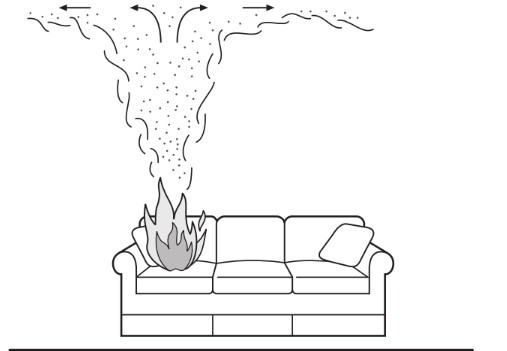
Fire sprinklers are activated by convective heat transfer. In Operation of Fire Protection Systems, the authors sum up the process as follows:
Within a room, a plume of hot gases will rise until it hits the ceiling and then splits, forming a ceiling gas jet that pushes out to both sides of a room. The thickness of this jet flow is roughly between 5 and 12 percent of the height of the ceiling above the source of the fire. When a sprinkler is trapped within the ceiling jet, its heat-sensing element is heated via conduction of the heat from the air. Once the thermal element’s temperature threshold is met, it activates.
What causes a fire sprinkler to activate? Thermal elements are carefully designed to prevent accidental sprinkler activations
Of course, it takes more than a standard heat source to trigger a sprinkler system and spray a room with water. Sprinklers must detect a high enough temperature to activate—typically, temperatures of 135° F, 155° F, or 250° F (57° C, 68° C, or 121° C).
The reason for the different temperature triggers is clear: Various residential, commercial, and industrial environments operate at different ambient temperatures, so some fire sprinkler heads must be able to resist higher levels of heat before activating.
To avoid accidental discharges, it’s important to match the temperature rating of the sprinkler to the ordinary and maximum expected ceiling temperatures of a property. And while such activations are rare, it’s also wise to avoid placing sprinklers close to objects that might emit high levels of heat, like construction lighting, skylights, or television cameras.
Most sprinklers are held closed by a small glass bulb that contains a heat-sensitive, glycerin-based liquid. These trigger mechanisms keep a pip cap in place, also known as the sprinkler’s “plug.”
When the air around a sprinkler reaches a certain temperature, the liquid inside the bulb expands until the pressure causes the glass to break. In wet sprinkler systems, pressurized water in the pipes then forces out the plug and flows over a deflector plate that sprays it onto the fire in a carefully designed pattern. The water continues to flow until the main valve is shut or the supply runs out.
Watch this video to see a glass bulb fire sprinkler activate in slow motion:
It’s essential for water in a fire sprinkler system to be pressurized, giving it enough force to spray outward in an arc so it can thoroughly douse a fire and prevent flames from reigniting. The 2019 edition of NFPA 13: Standard for the Installation of Sprinkler Systems requires a minimum operating pressure of 7 psi, or pounds per square inch, (0.5 bar) for any sprinkler head (27.2.4.11.1).
In a dry sprinkler system, the activated sprinkler head causes the air pressure in the pipes to drop, opening a dry pipe valve near the system riser that holds back the water. The water floods the pipes and sprays through the open sprinkler, which can take up to 60 seconds.
Sprinkler heads that rely on fusible metal links replace the glass and liquid with two metal plates held together by a solder with a predetermined melting point. When the area around the sprinkler head reaches the critical temperature, the solder melts and two spring arms pull the plates apart. The plug falls away and the water it was holding back—or in dry sprinklers, pressurized gas followed by water—flows through the sprinkler head.
If the fire is small, only the sprinkler directly above it will activate, leaving the rest of the property dry and secure. However, if flames spread, the heat will trigger nearby sprinklers as well to control the fire.
To learn more about how the thermal sensitivity elements in fire sprinklers work, check out our previous blog, “How a Fire Sprinkler Works: Thermal Sensitivity.”
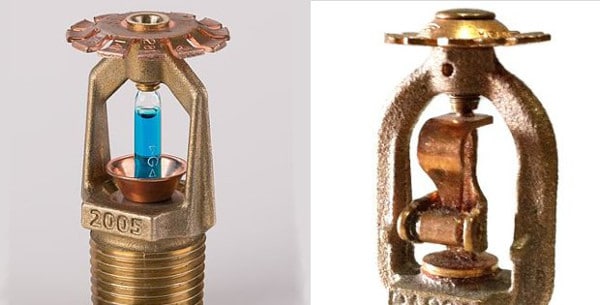
Color codes make fire sprinkler temperature ratings readily apparent
A sprinkler’s temperature rating is stamped on a visible part of a fusible-link or a glass-bulb sprinkler’s head. But NFPA 13 also goes a step further and requires automatic sprinklers to use color codes to make their temperature rating instantly apparent. The color of the liquid inside a glass bulb reveals its temperature rating. For fusible link sprinklers, the color code is usually located on the frame arms.
From the 2019 Edition of NFPA 13
7.2.4.1 Automatic sprinklers shall have their frame arms, deflector, coating material, or liquid bulb colored in accordance with the requirements of Table 7.2.4.1 or the requirements of 7.2.4.2, 7.2.4.3, 7.2.4.4, or 7.2.4.5.
7.2.4.2 A dot on the top of the deflector, the color of the coating material, or colored frame arms shall be permitted for color identification of corrosion-resistant sprinklers.
7.2.4.3 Color identification shall not be required for ornamental sprinklers such as factory-plated or factory-painted sprinklers or for recessed, flush, or concealed sprinklers.
7.2.4.4 The frame arms of bulb-type sprinklers shall not be required to be color coded.
7.2.4.5 The liquid in bulb-type sprinklers shall be color coded in accordance with Table 7.2.4.1.
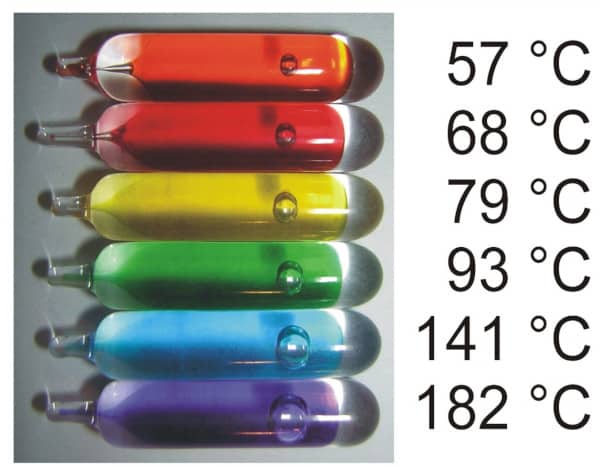
The table below shows the appropriate color coding for fusible link (the “color code” column) and glass bulb fire sprinklers:
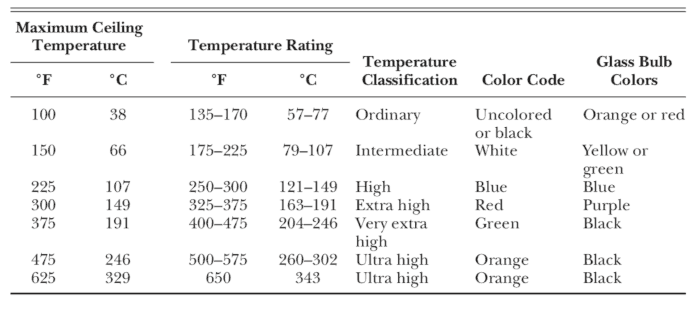
How to measure a fire sprinkler’s thermal sensitivity
Thermal sensitivity defines how fast a heat-responsive element operates within a fire sprinkler. Measuring this process determines the thermal sensitivity of a sprinkler.
NFPA 13 characterizes sprinkler operating elements as “fast response” or “standard response,” depending upon their response time index (RTI). Now read this carefully: These terms refer to the sensitivity of the thermal element and not the time it takes sprinklers to fully operate. Operation times are impacted by many other factors in installation, including ceiling height, spacing, ambient room temperature, and distance below the ceiling.
NFPA 13 (A.3.3.205.2) notes that operation times are generally shortest when the thermal element is located 1-3 inches (25-75 mm) below the ceiling. Obviously, a fast response sprinkler is expected to operate quicker than a standard response sprinkler with the same installation.
From the 2019 edition of NFPA 13
3.3.205.2 One measure of thermal sensitivity is the response time index (RTI) as measured under standardized test conditions.
(a) Sprinklers defined as fast response have a thermal element with an RTI of 50 (meters-seconds)½ or less.
(b) Sprinklers defined as standard response have a thermal element with an RTI of 80 (meters-seconds)½ or more.
The RTI for a specific model sprinkler is typically determined by a “plunge test” in a “plunge oven.” The process is also referred to as an “oven heat test” in UL 199: Standard for Automatic Sprinklers for Fire Protection Service, which provides requirements for automatic sprinklers intended for installation on fire sprinkler systems. UL, formerly known as Underwriters Laboratories, is a global safety certification organization.
Here’s how a plunge test works: Within the plunge oven, a heated air stream moves through a metal duct at a constant velocity and temperature. A sprinkler maintained at room temperature is plunged into the air stream.
The amount of time it takes to trigger the sprinkler’s thermal element—reaching roughly 63 percent of the temperature of the heated air stream—is measured in seconds. This measurement is known as the “tau factor.” Multiplying the tau factor by the square root of the velocity reveals the sprinkler’s RTI. The lower the value, the faster the sprinkler response.
Put as an equation:
RTI= τυ½
τ= tau factor
υ= air velocity
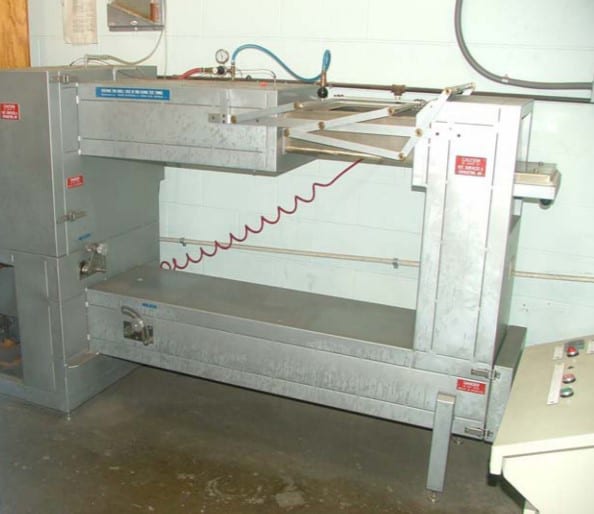
Standard response vs. fast response sprinklers: which activation is right for your property?
NFPA defines fast response as a broad category that includes several types of sprinklers, including quick response, residential, quick response extended coverage, and early suppression fast response (ESFR) sprinklers. All other sprinklers are classified as standard response by NFPA.
The International Organization for Standardization (ISO) also recognizes a “special response” category that includes sprinklers with an RTI greater than 50 but less than 80. NFPA 13 (A.3.3.205.2) states that special response sprinklers can be recognized as “special sprinklers,” as defined by 15.2.1:
From the 2019 edition of NFPA 13
15.2.1 Special sprinklers that are intended for the protection of specific hazards or construction features shall be permitted where such devices have been evaluated and listed for performance under the following conditions:
(1) Fire tests related to the intended hazard
(2) Distribution of the spray pattern with respect to wetting of floors and walls
(3) Distribution of spray patterns with respect to obstructions
(4) Evaluation of the thermal sensitivity of the sprinkler
(5) Performance under horizontal or sloped ceilings
(6) Area of design
(7) Allowable clearance to ceilings
The only physical difference between fast response and standard response sprinklers is the bulb size. Standard response sprinklers have a 5 mm glass bulb and fast response sprinklers typically include a 3 mm glass bulb. The thinner glass bulb breaks faster and speeds thermal responsiveness. In an average-size room, a 5 mm glass bulb typically breaks after 60 to 90 seconds of contact with a heat source.
Standard response fire sprinklers are usually found in warehouses, factories, and other commercial or industrial buildings. They are designed to pre-wet materials around a fire, eliminating its fuel source and either extinguishing the blaze or containing it in its original location until the fire department arrives.
Fast response fire sprinklers are primarily installed in light-hazard applications like office buildings, homes, or schools. While they have similar fire-control benefits as a standard response sprinkler, their main goal is to improve the odds of human survival during a fire. These sprinklers release water higher up on the ceiling to cool it and prevent flash-over.
It’s important to note that some sprinklers only listed or approved as standard response may actually incorporate a fast-response thermal element. These sprinklers must still be installed under the design parameters for standard response sprinklers. For this reason, it is critical to review the manufacturer’s technical data to verify listings and approvals before installing sprinklers on a property.
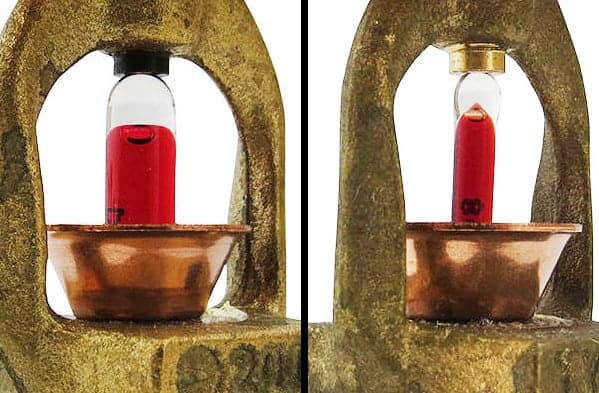
Understanding what causes a fire sprinkler to activate erases common misconceptions that prevent people from installing them
In less time than it typically takes the fire department to arrive on the scene, sprinklers can contain and even extinguish a fire. NFPA asserts that your risk of dying in a home fire soars by 81 percent if fire sprinklers aren’t installed. Property damage in hotel fires alone is 78 percent less when sprinklers are present, with average losses coming in at $2,300 in sprinklered buildings and $10,300 in unsprinklered structures.
Understanding what causes fire sprinklers to activate—and what does not—can help dispel the stubborn misconceptions that surround these life-saving tools and enable property owners to install them with confidence.
Looking to purchase fire sprinkler heads for a system? View our in-stock selection of commercial pendent, upright, sidewall, and concealed fire sprinklers, or our selection of residential fire sprinklers.
For more information about QRFS products, call us at +1 (888) 361-6662 or email support@qrfs.com.
This blog was originally posted at blog.qrfs.com. Check us out at Facebook.com/QuickResponseFireSupply or on Twitter @QuickResponseFS.


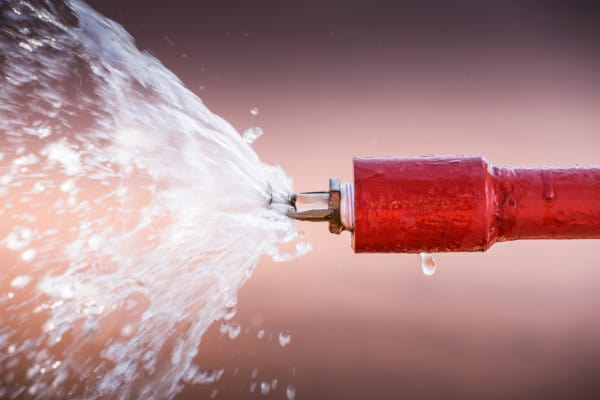
Can fire sprinkler be activated buy cooking a steak in searing oven which uses temp 1500F?
Teresa — The short answer: we can’t say for sure as it depends on how far the sprinkler is from the heat source, the resulting ambient temperature around the sprinkler, and the sprinkler’s activation temperature. For example, NFPA 13: Standard for the Installation of Fire Sprinklers has this provision in section 9.4.2.5 that calls for using sprinklers that activate at higher temperatures in light of temp. measurements:
“Sprinklers protecting commercial-type cooking equipment and ventilation systems shall be of the high- or extra-high-temperature classification as determined by use of a temperature-measuring device. (See 8.9.6.)”
In addition, there are requirements for ordinary or intermediate temperature sprinklers to be a certain distance away from various heat sources in residential settings in table 9.4.2.5(b) — but a 1,500F oven sounds like a commercial setting. You should contact a qualified fire protection contractor to assess your situation and determine the temperatures and sprinkler types that will be appropriate. Best of luck!